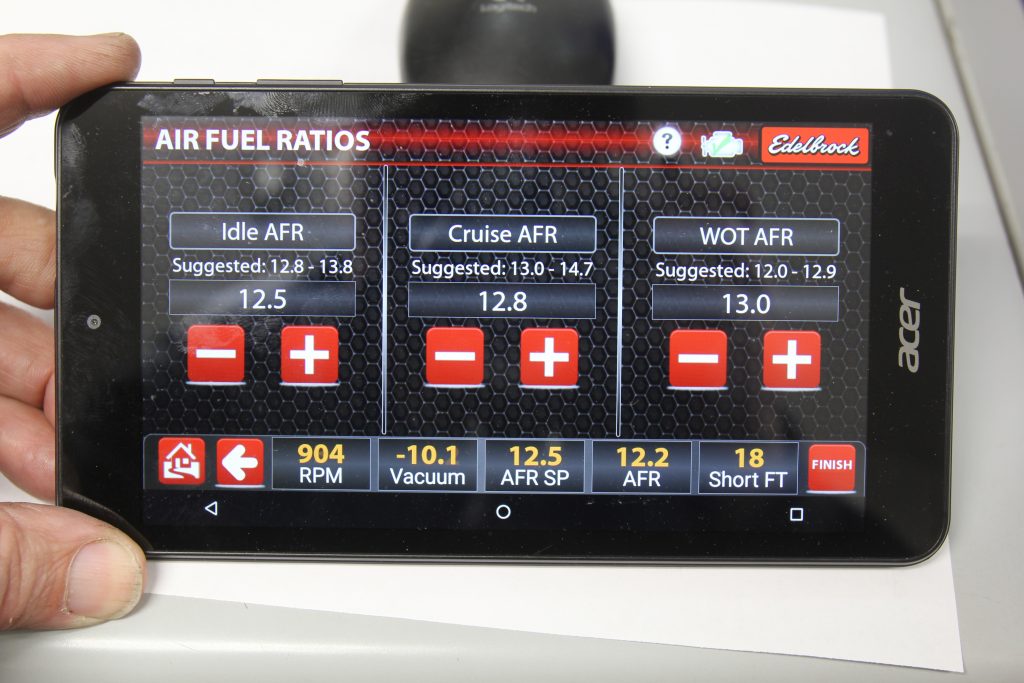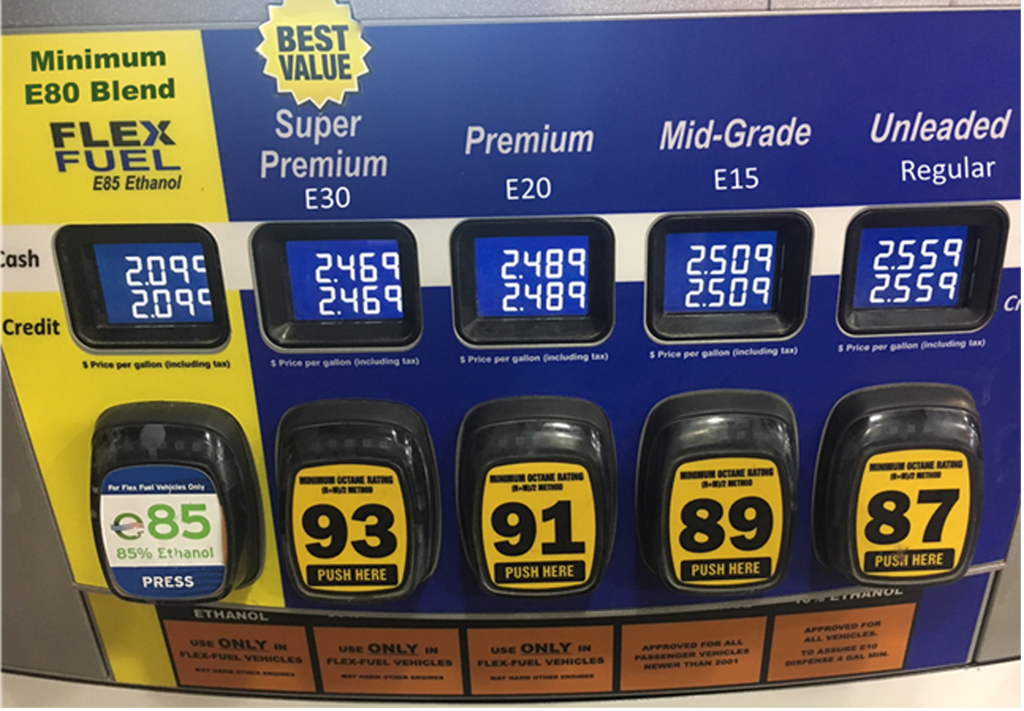I’m trying to dial in my old Ford friend of 45 years, a 1972 Ford Mustang with a 351 Cleveland with 2-barrel heads. The engine has a Crane hydraulic roller cam with 216/224 degrees duration, 112 LSA, and 0.562 inch intake/0.586 inch exhaust lift. The compression is 9:6:1 and I run Fitech EFI.
The idle air-fuel ratio setting is 13:7:1. Just off throttle at 1,100 RPM the AFR is at 14:2:1. At the higher cruise setting of 3,000 RPM, AFR is also 14:2:1. Ignition timing is 15 degrees initial, 36 degrees total all in by 3,500 RPM. I also have a C-6 tranny with a 2,700 RPM stall converter. Rear gearing is 3:25:1.
Could you please take a look at the air fuel ratios and tell me what you think. I love your articles and thank you for your response.
G.C.
You didn’t mention how the car runs at these settings. Since you don’t mention any problems, I’m assuming engine operation is acceptable. The reason I chose your question relates more to the indicated air-fuel ratio (AFR) and assumptions that running really lean will improve fuel mileage and make the engine more responsive to the throttle. While this may be true in certain circumstances, there are some hidden issues that tuners should be made aware of as they affect what these numbers really mean.
Before we get into the details, I’d like to inject a small piece of advice I learned from a very knowledgeable friend of mine, Jim McFarland. Jim was editor of Hot Rod magazine during the late ‘60s and served as the Director of Engineering at Edelbrock for many years. One day on the dyno, we were adjusting the air-fuel ratio using a very early air-fuel ratio meter and he warned “Don’t get too caught up in the numbers. Just give the engine what it wants and let the numbers be what they are.” That advice has served me well over many decades. So having made that point, we can dissect the numbers.
The first point is that air-fuel ratio meters don’t actually measure the ratio of air to fuel. These instruments record the percentage of free oxygen in the exhaust. In the case of perfect combustion (which is mainly theoretical) there will exist an ideal chemical reaction that results in a very high percentage of carbon dioxide (CO2) and a near zero percentage of carbon monoxide (CO). This also results in minimal free oxygen because nearly all the oxygen is converted to either CO or CO2. A high percentage of CO2 means good combustion but there will still be some free oxygen in the exhaust. Air-fuel ratio meters measure this free oxygen and then use a formula to compute the AFR.
Here’s where it gets tricky. Most (if not all) air-fuel meters use 14.7:1 as the reference point for the ideal AFR for gasoline. This is called the stoichiometric AFR. The problem is that roughly 90 percent of all pump gasoline sold in the U.S. today is mixed with 10 percent ethanol. Since ethanol has a much richer (9.0:1) stoichiometric AFR than gasoline, this means that the true stoichiometric AFR of nearly all pump gasoline is actually 14.1:1. This is a major shift of 0.6 of a point. This will skew all of your readings, actually making the indicated 14.2:1 AFR reading on your instruments more like 13.6:1.
To expand, if the gauge indicates 12.9:1 under wide-open throttle (WOT), actual AFT is really closer to 12.3:1 if we are talking straight gasoline. The mixture is slightly richer by about a half ratio than the gauge reads.
Generally speaking, older engines from the 1960s and ‘70s do not benefit from efficient combustion chamber design, which means they don’t like to run very lean. Your 14.2:1 AFR at 3,000 RPM cruise is closer to 13.6:1 because of the 10 percent ethanol blend. This is probably about as lean as this engine will want to run, although it might actually be good at around 13.8:1 or so.
Having to continually “correct” these ratios can become confusing, so let’s consider looking at this a different way. Most air-fuel ratio meters offer an optional display in something called Lambda. This is just a Greek letter term for stoichiometric. A trick that engine builder Kenny Duttweiler showed me is to forget the different air-fuel ratios for the various fuels and just use Lambda.
Let’s work through a couple of examples to show how this works. For straight gasoline, 14.7:1 equals 1.0 Lambda. Any number smaller than 1.0 is richer than stoichiometric and any number larger than 1.0 is leaner. For example, multiply Lambda by 0.9 (14.7 x 0.9). The result is 13.23:1 AFR. If you multiple Lambda by 1.03 (14.7 x 1.03) we get 15.1:1 AFR.
A shortcut for tuning for maximum power would be Lambda times 0.85. Let’s see how this works with pure gasoline (no ethanol). Multiply 14.7 by .085 and the resulting AFR is 12.49:1 (rounded to 12.5:1). This number is often used as a starting point for WOT AFR tuning. For E10 gasoline at 14.1:1 stoichiometric, AFR is 11.98:1, or about a half-ratio richer than straight gasoline.
Rather than try to keep all of the different AFRs straight in your head, use Lambda at 0.85 for maximum power, shoot for around 0.95 as a cruise AFR starting point, then try minor tuning changes to see how the engine responds. If the engine wants more fuel, that’s what you should do and not worry about what the gauge reads.
As an example, we had a rather large 540 cubic inch Rat motor on the dyno. After tuning, we set the load on the dyno at roughly 50 lbs.-ft. of torque and RPM at 2,700 to simulate driving down the highway in high gear. The engine wanted roughly 46 degrees of timing (remember this is a 4.50-inch bore engine with a large combustion space). Every time we added timing, torque improved. Then we tried leaning the AFR from 13.8:1 to 14.2:1 and that hurt torque. What the engine really wanted was as much fuel as we could give it; torque improved even with the AFR at 12.5:1. Clearly the fuel mileage would be terrible at this AFR, but the engine would be making power. As an estimate, the indicated cruise AFR would probably be something like 13.6:1, which would put the true AFR with E10 fuel at roughly 13.0:1.
This answer might just have left you more confused, but I thought it was important to at least bring up the topic to make tuners aware that AFR gauge readings are not really completely accurate. If your gauge will display in Lambda, you might want to try that to see if it works for you. A max power Lambda number will be roughly 0.85 and a good cruise Lambda reading would be around 0.95 to start.
You may need to read this answer a couple of times to completely grasp what is happening here. Frankly, we had to be very careful to make sure this answer stayed on course! Experimenting with tuning will reveal what your engine really wants, but the numbers displayed on your gauge will appear to be much leaner than you are comfortable or familiar with for the reasons we’ve described. The reality is that given the “richer” stoichiometric of E10 pump gas, the engine is not as lean as it appears.



[…] I’m trying to dial in my old Ford friend of 45 years, a 1972 Ford Mustang with a 351 Cleveland with 2-barrel heads. The engine has a Crane hydraulic roller […] Read full article at http://www.onallcylinders.com […]
Jeff have had any experience with the PRO-M MASS AIR SYSTEM?
I have a 1992 Mazda b2200. I am told it’s a Ranger clone, and summit sells a v-8 kit for rangers- will this work for me?
Thanks